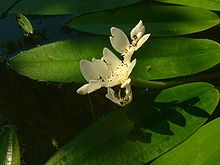
Nelumbo nucifera, also known as sacred lotus, Laxmi lotus, Indian lotus, or simply lotus, is one of two extant species of aquatic plant in the family Nelumbonaceae. It is sometimes colloquially called a water lily, though this more often refers to members of the family Nymphaeaceae.

Elodea canadensis is a perennial aquatic plant, or submergent macrophyte, native to most of North America. It has been introduced widely to regions outside its native range and was first recorded from the British Isles in about 1836.
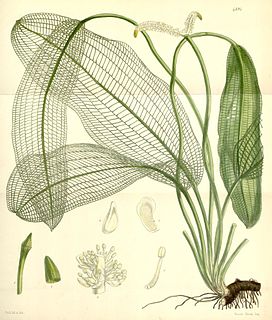
Aponogeton madagascariensis is commonly known as Madagascar laceleaf, lattice leaf or lace plant. It is an aquatic plant native to Madagascar, popularly sold for use in aquariums. It is endangered in the wild.

Nymphaea lotus, the white Egyptian lotus, tiger lotus, white lotus or Egyptian white water-lily, is a flowering plant of the family Nymphaeaceae.
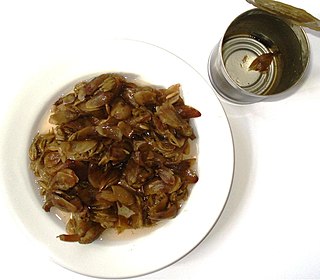
Waterblommetjiebredie is a stew. The name comes from the Afrikaans language and literally means 'little water flowers stew'. It is made of meat, typically lamb, stewed together with the waterblommetjies which are found in the dams and marshes of the Western Cape of South Africa. The buds of Aponogeton distachyos are usually ready to be picked in the southern midwinter months of July and August, leading to their use in winter stews such as waterblommetjiebredie.

The Aponogetonaceae are a family of flowering plants in the order Alismatales.
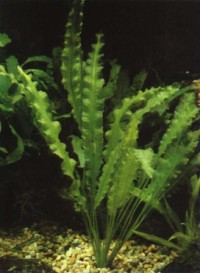
Aponogeton crispus is an aquatic plant species.

Aponogeton ulvaceus is a submerged aquatic plant in the Aponogetonaceae family. It has a small cone shaped, slightly hairy rhizome about 30 mm in diameter. The leaf blades have a base that tapers gradually, pale green in colour, over 50 cm (20 in) long and 8 cm (3 in) broad, with a wavy margin on petioles of an equal length, and in appearance slightly translucent. A single bulb may produce up to forty leaves in good conditions. No floating leaves are formed. The yellow flowers are produced on one or two, and sometimes more, erect spikes.
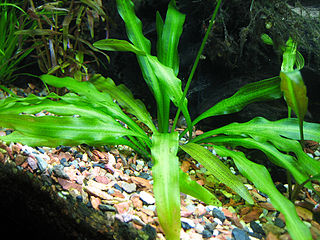
Aponogeton undulatus is a species of aquatic plant, sometimes used in aquariums. Some taxonomists consider this should be under the name Aponogeton stachyosporus.
Aponogeton longiplumulosus is a submerged aquatic plant that is native to Madagascar. It possesses an elongated rhizome 2–3 cm in diameter. The leaves are an olive green-brown, 8 - 14 inches (20–35 cm) long and 2.5 inches (6 cm) broad, with a fluted margin and a petiole up to about 24 inches (60 cm) long. No floating leaves are formed. New leaf colour forms have been introduced recently. The flowers are a dark violet in colour.

Aponogeton rigidifolius is a species of freshwater plant native to Sri Lanka. In the wild it grows in deep water at temperatures of 68 to 77 °F in sandy soil with the water pH at 7.2.

Oxalis triangularis, commonly called false shamrock, is a species of perennial plant in the family Oxalidaceae. It is native to several countries in southern South America. This woodsorrel is typically grown as a houseplant but can be grown outside in USDA climate zones 8a–11, preferably in light shade.

Ornamental bulbous plants, often called ornamental bulbs or just bulbs in gardening and horticulture, are herbaceous perennials grown for ornamental purposes, which have underground or near ground storage organs. Botanists distinguish between true bulbs, corms, rhizomes, tubers and tuberous roots, any of which may be termed "bulbs" in horticulture. Bulb species usually lose their upper parts during adverse conditions such as summer drought and heat or winter cold. The bulb's storage organs contain moisture and nutrients that are used to survive these adverse conditions in a dormant state. When conditions become favourable the reserves sustain a new growth cycle. In addition, bulbs permit vegetative or asexual multiplication in these species. Ornamental bulbs are used in parks and gardens and as cut flowers.

Nymphaea nouchali, often known by its synonym Nymphaea stellata, or by common names blue lotus, star lotus, red water lily, dwarf aquarium lily, blue water lily, blue star water lily or manel flower, is a water lily of genus Nymphaea. It is native to southern and eastern parts of Asia, and is the national flower of Bangladesh and Sri Lanka. In Sanskrit, it is utpala. This species is usually considered to include the blue Egyptian lotus N. nouchali var. caerulea. In the past, taxonomic confusion has occurred, with the name Nymphaea nouchali incorrectly applied to Nymphaea pubescens.
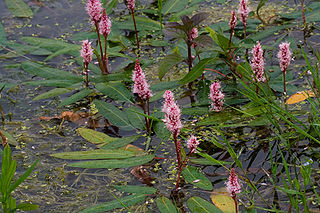
Persicaria amphibia is a species of flowering plant in the knotweed family known by several common names, including longroot smartweed, water knotweed, water smartweed, and amphibious bistort. It is native to much of North America, Asia, Europe, and parts of Africa, and it grows elsewhere as an introduced species and sometimes a noxious weed.

Cape Lowland Freshwater Wetland is a critically endangered vegetation type of the Western Cape, South Africa.

Scirpus ancistrochaetus is a rare species of flowering plant in the sedge family known by the common names barbedbristle bulrush and northeastern bulrush. It is native to the northeastern United States from New Hampshire south to Virginia. It used to be found in Quebec but it is now thought to be extirpated there. It was also believed extirpated from the state of New York, but at least one population has been rediscovered in Steuben County in 2010. It is threatened by the loss and degradation of its wetland habitat. It is a federally listed endangered species.

Aponogeton bernerianus is an aquatic plant from eastern Madagascar. It has a 3 cm thick tuber or thick and branchy rhizome. Leaf blade up to 13 cm petiolate, strap-shaped, highly bullate and undulate, up to 50(-120) cm long and 1.5-6.5(-10) cm wide, dark green coloration. Peduncle up to 75 cm long, tapering towards the inflorescence. Spathe up to 15 mm long, caducous. Inflorescence with 3-15 up to 8-cm long spikes with omnilateral flowers; 2(3) white tepals; 6 stamens; 3(4) carpels with 2 ovules each. Fruit about 10 x 7 mm. Seed about 7x4 mm in size, simple testa.

Aponogeton lakhonensis is a species of an aquatic genus Aponogeton, itself the only genus in the Aponogetonaceae family. This species with a yellow-flowered single spike rising above the water, is found in ricefields, ponds and slow-moving streams of tropical and sub-tropical Asia. An outlier population occurs in Sulawesi, the main area of occurrence is from Thailand to Zhōngguó/China and Assam in India. It is more closely related to tropical Australian species of Aponogeton than it is to other Southeast Asian species. In Thailand the whole plant is eaten is salads, whereas Cambodians prefer the leaves alone served with fish sauce.

Iris hexagona, commonly known as the Dixie iris, is a species in the genus Iris, it is also in the subgenus Limniris and in the series hexagonae. It is a rhizomatous perennial with long bright green leaves, long thin stem and has small groups of flowers in shades of blue, from violet, to bluish purple, to lavender. It flowers in springtime and is native to the southeastern and south-central US states.
